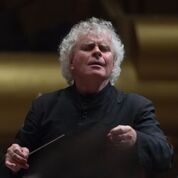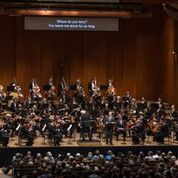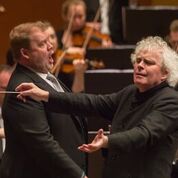
Photo by Kevin Yatarola
So often when star musicians such as Simon Rattle hit a golden spot in their late 30s and early 40s, you stand back and ask, “Where can they possibly go from there?”
Everybody’s darling conductor in the 1990s, Rattle certainly invited that kind of speculation, though his Berlin Philharmonic years (2002 to the end of this summer) left only provisional answers: You never knew how much he was being filtered by that orchestra’s strong, collective personality, especially after his famous quote that he and the Berlin players sometimes don’t agree on anything.
Rattle has also said that conductors tend not to achieve greatness until they’re 60. So his New York Mahler festival in his first season as London Symphony Orchestra music director – at age 63 – prompted high expectations. And it delivered more than enough answers about him, the orchestra and the direction of 21st-century Mahler performance – though not until the final concert that represented Mahler’s ultimate end point.
The short-ish programs, presented May 4-7 by Lincoln Center’s Great Performers series at David Geffen Hall, featured the three major works that Mahler never lived to hear (he died in 1911), all influenced by his life in New York City, where he led the Metropolitan Opera and New York Philharmonic. The Symphony No. 9, Das Lied Von der Erde, and the unfinished Symphony No. 10 arrived in that order, each a chapter (more like a novel) showing the composer coming to terms with impending death, spiritually, cosmically, and carnally.
The London Symphony Orchestra has had some great periods, though not consistently enough to be called one of the world’s greatest orchestras in the same breath as Berlin, Vienna, and Amsterdam. Yet those orchestras can be prisoners of their own institutional sound. Berlin, in particular, feels chrome-plated, so that in those infrequent instances where notes are dropped, they seem to clatter on the stage floor more obviously than with a chameleon orchestra such as the LSO.
The opening minutes of the first concert, the Mahler 9th, had one of those moments where the sound expands far beyond expectation in ways that recalled the Berlin Philharmonic. My initial reaction was cynical: Rattle is just showing the world that the London Symphony can match the Berliners in that regard. Minutes later, the Londoners showed their vulnerability: there were slightly mis-tuned inner voices amid the symphonic texture. But skepticism melted quickly: That monumentalism was part of what one might call Rattle’s high-def 3-D approach to Mahler. On recordings, it can seem overwrought and mannered, but in person, it is absolutely seismic.
Rattle’s cinematic approach to Mahler has been building for a few decades. This is something different from the years when Leonard Bernstein and Giuseppe Sinopoli wrung maximum expression out of the symphonies. Rattle has been there and done that, and he’s now revealing the music through the larger world that the pieces inhabited. And in particular, he’s doing so through the lens of where Mahler was headed with the Symphony No. 10, a work that many Mahler specialists won’t conduct beyond the first movement, declaring the rest to be too unfinished. Rattle, in contrast, has championed the Symphony No. 10 as far back as 30 years ago with his recording of the piece with the Bournemouth Symphony Orchestra.
With Mahler’s 10th perhaps in his mind’s eye, Rattle backtracks to earlier works, exercising the freedom to do what might be called breaking the fourth wall. (That’s a theatrical term for when actors in a play start to address the audience directly.) In Mahler, the performance is no longer a frame for a piece: The frame disappears as the music ceases to go beyond suggestion. And into … what? Toward the more unfiltered level of artistic veracity that Mahler achieved in the 10th. Earlier Mahler pieces have nature descriptions not so far away from Beethoven’s “Pastoral” Symphony, but they’re still instances of music describing something in nature. Something beyond that happens in the later Mahler symphonies, and Rattle tapped into it.
Example: The famously expansive flute solo that encapsulates nothing less than existential abandonment in the final song of Das Lied von der Erde has always suggested a Chinese flute – in keeping with the ancient Chinese poems on which the piece is based. With Rattle, that solo becomes a Chinese flute: the soloist plays a symphonic instrument in the manner of a folk instrument, with a vibrato-less, unvarnished sonority. Harps go beyond merely suggesting Chinese pipas, impersonating the traditional lutes and more clearly revealing the starting point of Mahler’s inspiration.
Rattle’s approach takes immense guts and insight. In fact, it has been said that one reason conductors get great after 60 is that they care less what people think. He’s not the only one: David Zinman’s recordings are just as bold in their highly specific imagery but not writ quite so large as Rattle’s performances. (That’s one reason why Zinman may wear better over the long run.)
And Mahler is not the only composer currently being taken through the looking-glass in that manner. Old Richard Strauss recordings conducted by the composer, and Debussy conducted by the composer’s trusted friend Désiré-Émile Inghelbrecht, show the pieces emerging as clear, unclouded creations that challenge listeners to meet them halfway.
Not now. In present-day performances of Strauss’s Till Eulenspiegel, don’t be surprised if you hear moments where the piece’s reckless protagonist seems to be urinating. Performances of Debussy’s La Mer become ocean (to borrow a title from John Luther Adams). And this is not just in symphonic works. The difference began hitting me a few years back as I was making a study of French singers form the 1940s and ’50s. All elements are articulated with authority in the earlier performances. But in later ones by the likes of Christine Schäfer and Irwin Gage, Debussy comes with a far more extensive palette of Impressionistic colors evoking clouds, water and sunlight.
In an odd way, this trend could be seen as a philosophical extension of the early-instrument movement, which, in an effort to get closer to what was heard in the Baroque and Classical eras, relieved Bach, Mozart and others of the outer garments imposed onto the music by later performers. In Mahler, Rattle reverses the equation: He expands the outer garments with the assumption that the notes making up the music aren’t ends in themselves but are actually doorways into an endless unseen world. This performance practice may be quite different from what Mahler would’ve done himself as a conductor. But, as we know from the unbroken performance history of Stravinsky’s great works, forward-looking composers were initially concerned with simply getting the notes in the right places in works that were considered unplayable in some quarters.

Many of these currents were particularly present and even magnified in Rattle’s performance of the Mahler 10th, which was the greatest triumph in this series of landmark concerts in the New York season. Mahler was breaking new ground in the first and fifth movements, though the three inner movements in this unfinished work sound like steps backward. That’s typical of a work-in-progress (which the 10th certainly was): The inner movements feel like placeholders, showing generally what the composer was after until he could focus on something more specific. So, as they stand, why perform them at all? Because without them, we wouldn’t have the full view of how the innovations of Movement I circle back in Movement V. Rattle’s 3-D approach maximizes the content of the inner movements better than most conductors (as does Zinman but in his own manner) and gives credence to scholars who say that Mahler’s overall structural plan was the most daring of his entire symphonic output.
But there is much else to consider in the completed 10th. Is this Mahler’s most autobiographical symphony? All of his works have confessional qualities, though not rendered as graphically as the 10th symphony’s evocation of a New York City funeral procession with its stark, somber drum-pounding. The hammer blows in the Symphony No. 6 are clearly an antecedent, but those are abstracted to suggest a speculative look at the ruthlessness of fate. In the 10th, the funeral train for a fallen policeman that inspired Mahler was literally right outside his New York window, and it actually sounds that way in the symphony – a case of his outer life giving greater form and substance to his inner life. Elsewhere in the first and fifth movements are the famous piled-high dissonances – the orchestral scream, in other words – that also speak to the disintegration of Mahler’s outer world: His professional life in New York had grown extremely bumpy, his wife Alma was discovered to be having an affair with a younger man, and the heart condition that was to kill him (with the irregular heartbeats written into the 9th symphony) was growing worse.
Another case to be made for the inner movements: In his program note, Rattle identified the 9th symphony’s third movement as a clear portrait of the New York urban landscape. That’s debatable, but let’s think about what that could mean. The musical collage effects in, say, the Symphony No. 7‘s final movement come back in the 9th with more severe cross-cutting. Is this Mahler portraying the slapdash speed and homogeneity of New York, where so many different forces and elements were cheek by jowl? If that’s the New York element – which echt-New Yorker Elliott Carter later worked with in his own way – then such qualities are also reflected in the 10th symphony’s two similarly fashioned scherzo movements. So in their own somewhat unformed way, those movement became, in Rattle’s performance, an indispensable part of Mahler’s landscape.

Other than that, how were the concerts? Once past some momentary lapses, the London Symphony Orchestra played like a world-class group in ways that weren’t always the case under the late Colin Davis. In Das Lied von der Erde, Stuart Skelton coped with the cruel tenor vocal writing as well as anybody currently on the scene, and in place of the more typical contralto soloist, baritone Christian Gerhaher achieved an intimacy that was remarkable for a large concert hall. (It must be said that his somewhat mannered way of rhythmically punching the words in his December 2017 broadcast from London with Rattle was largely absent at Geffen Hall.)
Rattle’s tempos were flexible, and one is tempted to say well-judged, though the London Symphony players are so clearly on board with him that they took everything he gave them and made it all work.
Interestingly, the kind of expanse that Rattle gave the opening orchestral recitative at the start of Symphony No. 10 almost felt like an homage to the near-identical effect achieved by conductor/composer Berthold Goldschmidt in the 1964 premiere of the Deryck Cooke completion (the version that Rattle used). To me, the larger point is that Rattle’s progression as a Mahler interpreter builds on the past and seems not to put other interpreters in the shade. I can enjoy Zinman’s recordings as much as ever. (Okay, maybe Herbert von Karajan is sounding more like the Mahler interloper that he was.) Most Mahler symphonies welcome a huge range of interpretation – obviously because the density of content allows so many options.

